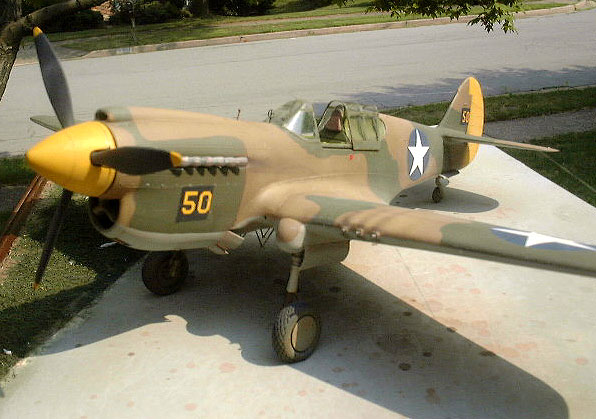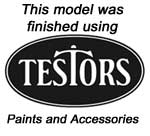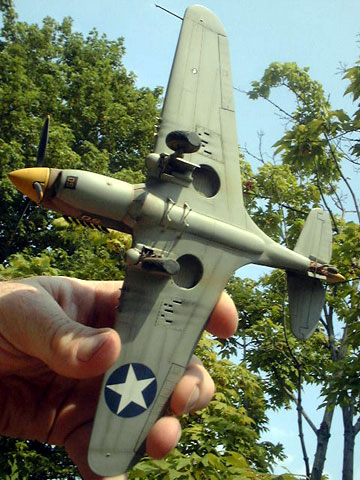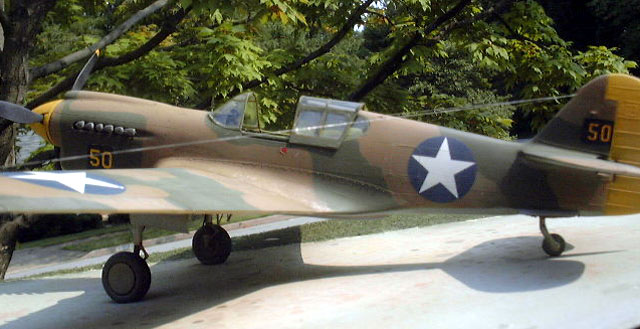|
Curtiss P-40E Warhawk
by
Floyd S. Werner Jr.
|

|
|
Curtiss P-40E Warhawk |

HyperScale is proudly supported by
Squadron.com
Why Revell's P-40E?
This kit was originally
released in 1978 and re-released in Monogram’s Promodeler series with a
few updates. I had this kit on the shelf and, after watching John Wayne
in “The Flying Tigers”, I decided it was time to add a P-40 to my
collection.
I knew that AMtech was
going to release a P-40E but I needed practice - practice in the fine
art of scribing panel lines. The P-40 has mostly straight lines so I
could work on them. Besides once the AMtech kit came out I knew I would
never build this classic kit from my childhood. It was off to the
workbench.
Why These Markings?
I flew Cobras in 1987
with a pilot named Rick Pierce. Rick’s father came to Germany and
visited. While he was there the unit had a party like only full blooded
Snake drivers can. Well Rick’s father took to our drinking real well and
being a southern gentlemen it only took a little prompting and he
started telling war stories. Rick had informed us that his dad had flown
during World War II but nothing else.
As it turned out Rick’s
father was Sammy Pierce of the 8th Fighter Squadron, 49th Fighter Group
flying in the Southwest Pacific. Once his stories started the guys
pretty much stopped talking, not drinking just talking, and listened. If
you ever get around pilots there was hand flying, beer drinking (oh how
I miss my German beer), the tales flew and by the end of the night we
were all humbled to be in such great company. Sammy flew P-40s and P-38s
and was an ace with seven kills. Since that night I have always wanted
to model Sammy’s machines. His normal mount was named “Kay-The
Strawberry Blonde/ Pistoff Pat”.

There are no decals for
this machine or his other P-40E “Yellow 50”. I bought an ALPS Printer
but so far great results are hard to achieve. Also the “Pistoff Pat” on
the right/crew chief side is not very clear so that left “Yellow 50”
which wasn’t nearly as flashy but still looked nice. Besides Sammy got
two kills in this machine. This aircraft is depicted on the cover of the
Schiffer book “Protect & Avenge” written by S.W. Ferguson and William
Pascalis.
Personally, I would like decal manufacturers to produce ace sheets.
Depicting all the aircraft of a specific pilot, like Aeromaster did with
Galland, Hartmann and von Maltzahn. Sammy flew two P-40Es (“Kay-The
Strawberry Blonde/ Pistoff Pat” and “Yellow 50”), one P-40N (“Kay-The
Strawberry Blonde/ The Hialeah Wolf”) and a P-38J (The Strawberry
Blonde). The Squadron Signal book “49th Fighter Group” features pictures
and drawings of three of Sammy’s planes but only the left side. His
P-40N will be a future project as soon as I figure out the printer.
Sammy’s P-38 is depicted on Three Guy Replicas sheet and when I feel
froggy I’ll jump all over the Academy or Hasegawa offering.
Revell's 1/48
Scale P-40E
|
As you can imagine the
quality of the kit is not up to today’s standards. It is molded in olive
green plastic with raised panel lines. The overall shape is very nice.
After I finished the kit
I found out that the tail seems a little too big. This was no big deal
for me. I’m happy with the looks of the kit. The kit is easy to build up
into a real nice model. The fit was overall pretty good, except the wing
root area. Nothing a modeler couldn’t fix.
Before I started to build
the kit I started scribing the panel lines. This was done by using Dymo
label tape and a scribing tool. A friend at the local club explained
that you should make only two lines, one in each direction with even
pressure throughout the cut. Once that was done I sanded off most of the
raised detail. I left some raised detail, as I didn’t think I could
replicate it as well as it looked raised. My kit, my rules. Anyway the
next trick to even lines is Testor’s Liquid Cement. Brush on a light
coat of the cement ONLY in the panel lines. This solvent is strong
enough to melt the plastic and smooth the scribed line. Finally I
checked it all with silver paint and one final coat of sanding. I did
all this before I even joined a seam. I was very happy with the results
and will try it again. With my practice done I had to build the kit.
One complaint I did have with the kit was that the cockpit was very
sparse. After all, it was molded in 1978. True Details came to the
rescue with their P-40 E-N Warhawk Cockpit Detail Set (Set 48451)
designed for the Mauve kit. This resin cockpit set is easily converted
to the Revell kit. You have to cut off the floor enough to get it to fit
in the fuselage and you have to cut the headrest off the seat but other
than that it fits like a charm and looks great. Polly-S colors were used
to paint the interior.

Another weak spot was the wheel wells. I used some Eduard stuff for the
wheel wells which spruced up this area nicely and some True Detail
wheels finished the landing gear area.
Had I thought about it I would have replaced the exhausts with Moskit
ones but I’ll save them for my next P-40. The propeller spinner needed a
panel line added so I used Post-it notes to scribe it. Post-it notes?
Yes I peeled as many as I need to get the panel line where I wanted to
with my scribing tool held firmly on top of the notes and spun the
spinner on my scribing tool. Accurate, straight and even lines. This
technique works for any circular item.
I tried a technique on the wings to get a good fit and some strength.
First I flat sanded the mating surface of the upper wings and the
fuselage join. Once this was done I attached each upper wing only. I
really did this before I even put the fuselage halves together. This
allowed me to compare them and make any small changes. I reinforced the
join on the inside with CA glue. This technique worked really well and
no filler was needed at the wing root. Next I ended up attaching the
lower wing to the upper portions after the cockpit was done. This part
required a little filler, especially in the back.
Overall I thought the fit was good for such an aged veteran. There were
some areas that required some filler and others that had to be sanded
down but nothing that you wouldn’t expect.
 I painted this aircraft
as one of the airplanes that were reacquired from the British so I tried
to get export Dark Earth and Dark Green. For me these ended up being
Polly-S Dark Earth, Aeromaster Dark Green and Testor’s Model Master
Italian Blue Gray. I painted this aircraft
as one of the airplanes that were reacquired from the British so I tried
to get export Dark Earth and Dark Green. For me these ended up being
Polly-S Dark Earth, Aeromaster Dark Green and Testor’s Model Master
Italian Blue Gray.
I used Cutting Edge Black
Magic masks designed for the Monogram P-40B but they worked with a
little bit of work and some spare masking material I lightened all
colors with some white and faded the camouflage as I thought
appropriate. I have to say that the overall look of the model was very
much what I was looking for - definitely something different from German
grays.
The decals are from various sources, including the kit American
markings. Surprisingly they did not shatter and reacted well with
setting solution.
Some final weathering with pastels and oils topped off with True Details
canopy and an MV, L 116, lens and I was done.
A Personal Opinion
 When you build a model
you have to ask yourself a couple of questions, and not just whether it
will win a contest. Did I have fun? Does it look like I wanted to? Most
importantly, do I like it? When you build a model
you have to ask yourself a couple of questions, and not just whether it
will win a contest. Did I have fun? Does it look like I wanted to? Most
importantly, do I like it?
If the answer to these basic questions is
yes
then you will know how I feel about modeling. Too many times modelers
build for contests or to impress somebody. If that is why you build a
kit then you aren’t enjoying the hobby. The possibilities an unbuilt kit
holds, the painstaking research, the building challenges, and the sense
of accomplishment upon completion, these are the things a finished kit
brings to me.
I know of so many people that start a kit and want to put so much into
it that the kit never gets built. Still there are others that won’t even
start a kit because they have to have everything perfect. Boys and girls
build a kit. Enjoy the process if not the end product. Our hobby is
supposed to be fun. If you win at a contest, great. If not who cares?
Try to learn something new on every model. Learn a new technique, a new
paint, a new way to weather, something that makes this one different.
Not all experiments work, but someone use to tell me it isn’t how bad
you screw up (not the words he used, Cobra driver) it is how gracefully
you recover. For me this model was a scribing exercise, it stretched my
limits.
Most people lose the motivation and dedication necessary to finish a
kit. It isn’t the finished product, it is the process by which you
arrive at the final results that makes modeling worthwhile. Remember, it
is better to have finished a kit than to never start one.
Off the Soapbox
and Back to the Conclusion
|
Revell's 1/48 scale P-40E
is a cheap offering at the vendor tables (bought mine for $5US) now and
with the True Details resin set the kit can be made into a nice
representation of a Warhawk. I really would like to build Sammy’s other
aircraft, especially his P-40E and N (that is a hint to decal
manufacturers).

The kit looks great built
but if I knew the AMtech kit was going to be as nice as it is, I
probably wouldn’t have started it. As it was, I finished the kit
after the AMtech offering was released. Why? Because I liked the
challenges and it looks good in my display case.
Bottom line - I learned
some things, I had fun, it looks like I wanted it to, and I like it. It
will never win a contest but who really cares? Certainly not me.
Finally, remember modeling is fun!
“49th Fighter Group,”
Squadron/Signal Publications, ISBN 0-89747-221-7
“Protect & Avenge”,
Schiffer Publishing, ISBN 0-88740-750-1 (Highly recommended)
Summary of
Aftermarket Items Used
|
-
True Details P-40E-N
Warhawk Cockpit Detail Set 48451
-
True Details P-40E-N
Wheel Set 48015
-
True Details Canopy
Unknown
-
Cutting Edge "Black
Magic" camouflage masks
-
MV Lenses L116
-
Eduard Photo-etch for AMT
P-40K Forgotten
Click the thumbnails below
to view larger images:
Model, Images and Text Copyright © 2002 by
Floyd S. Werner Jr.
Page Created 22 October, 2002
Last Updated 04 June, 2007
Back to HyperScale
Main Page
Back to
Features Index
|
Home
| What's New |
Features |
Gallery |
Reviews |
Reference |
Forum |
Search